Assessing Social Media's Role in Competitive Business Environment
VerifiedAdded on 2020/02/18
|12
|2580
|387
Report
AI Summary
This business research report comprehensively examines the impact of social media on contemporary business practices. It begins by introducing the topic, outlining the project's objectives, and defining its scope. The report then delves into a detailed literature review, exploring various perspectives on social media's influence on business operations, including its role in communication, marketing, and customer engagement. The research poses key questions regarding the benefits and threats associated with social media utilization, communication structures, geographical reach, and sustainable growth strategies. The methodology section details the research instruments, quantitative data analysis, sampling strategy, and design of questionnaires. It also addresses the reliability and validity of the collected data. The report acknowledges research limitations and includes a time schedule for the project. The conclusion summarizes the findings, emphasizing the importance of strategically leveraging social media for business success. References to relevant academic sources are included to support the research findings.
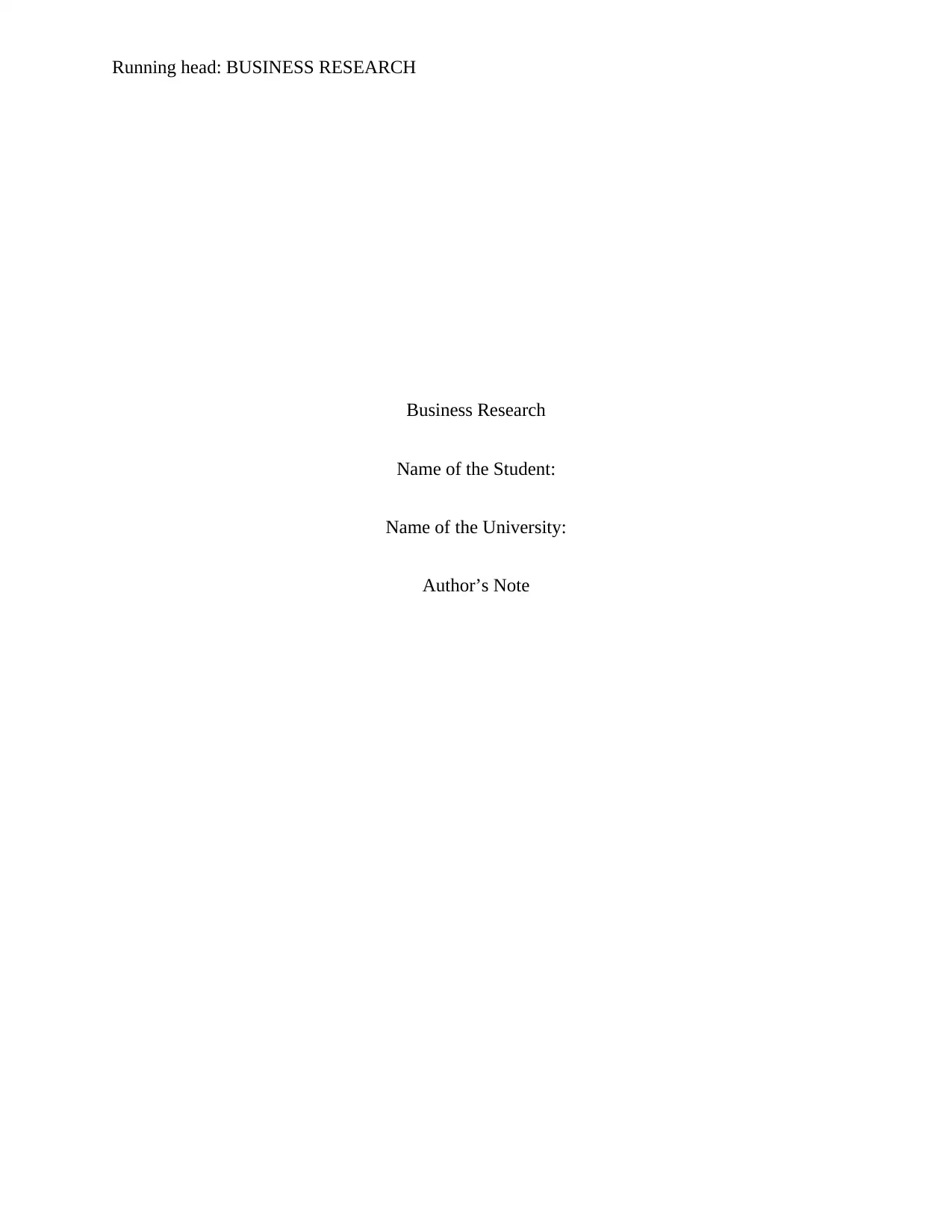
Running head: BUSINESS RESEARCH
Business Research
Name of the Student:
Name of the University:
Author’s Note
Business Research
Name of the Student:
Name of the University:
Author’s Note
Paraphrase This Document
Need a fresh take? Get an instant paraphrase of this document with our AI Paraphraser
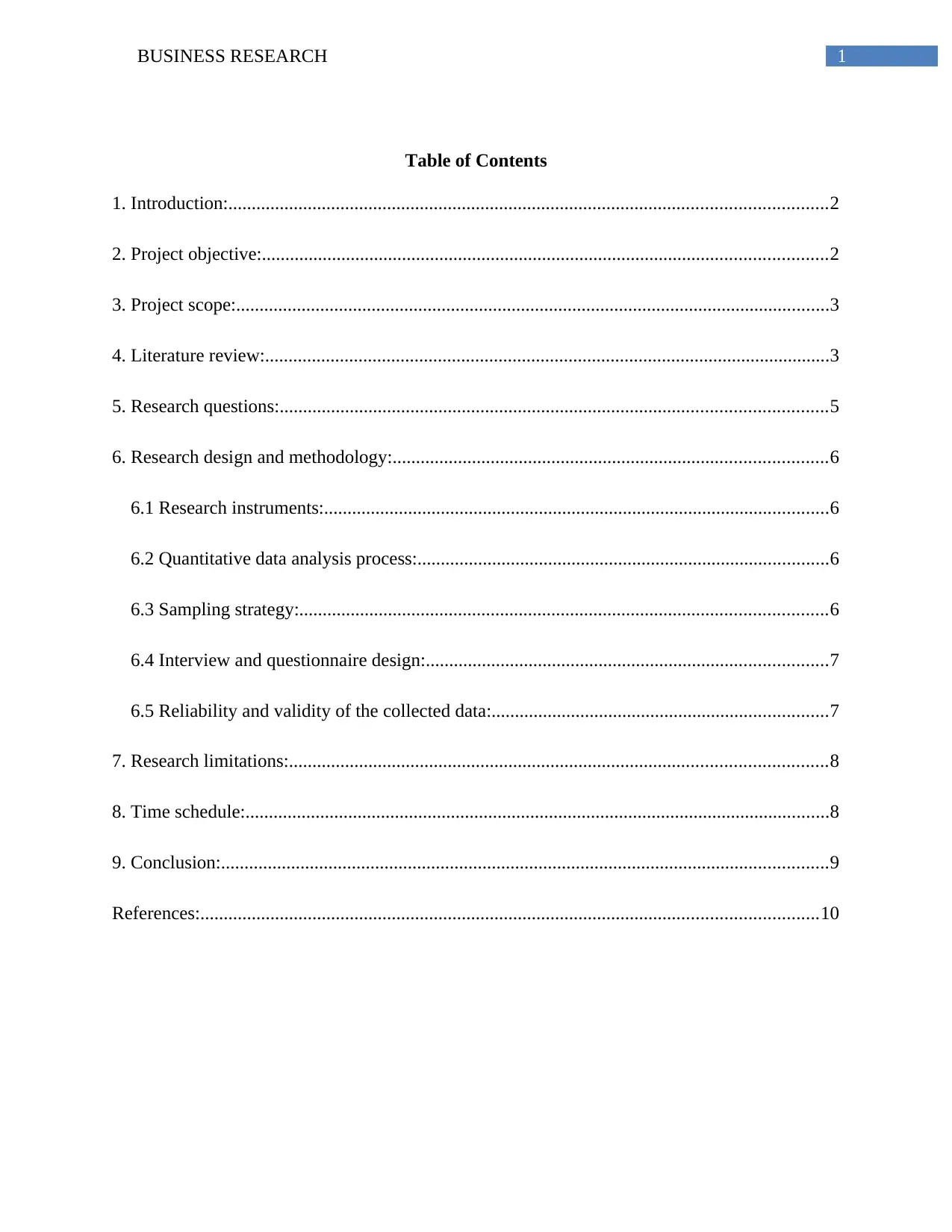
1BUSINESS RESEARCH
Table of Contents
1. Introduction:................................................................................................................................2
2. Project objective:.........................................................................................................................2
3. Project scope:...............................................................................................................................3
4. Literature review:.........................................................................................................................3
5. Research questions:.....................................................................................................................5
6. Research design and methodology:.............................................................................................6
6.1 Research instruments:............................................................................................................6
6.2 Quantitative data analysis process:........................................................................................6
6.3 Sampling strategy:.................................................................................................................6
6.4 Interview and questionnaire design:......................................................................................7
6.5 Reliability and validity of the collected data:........................................................................7
7. Research limitations:...................................................................................................................8
8. Time schedule:.............................................................................................................................8
9. Conclusion:..................................................................................................................................9
References:....................................................................................................................................10
Table of Contents
1. Introduction:................................................................................................................................2
2. Project objective:.........................................................................................................................2
3. Project scope:...............................................................................................................................3
4. Literature review:.........................................................................................................................3
5. Research questions:.....................................................................................................................5
6. Research design and methodology:.............................................................................................6
6.1 Research instruments:............................................................................................................6
6.2 Quantitative data analysis process:........................................................................................6
6.3 Sampling strategy:.................................................................................................................6
6.4 Interview and questionnaire design:......................................................................................7
6.5 Reliability and validity of the collected data:........................................................................7
7. Research limitations:...................................................................................................................8
8. Time schedule:.............................................................................................................................8
9. Conclusion:..................................................................................................................................9
References:....................................................................................................................................10
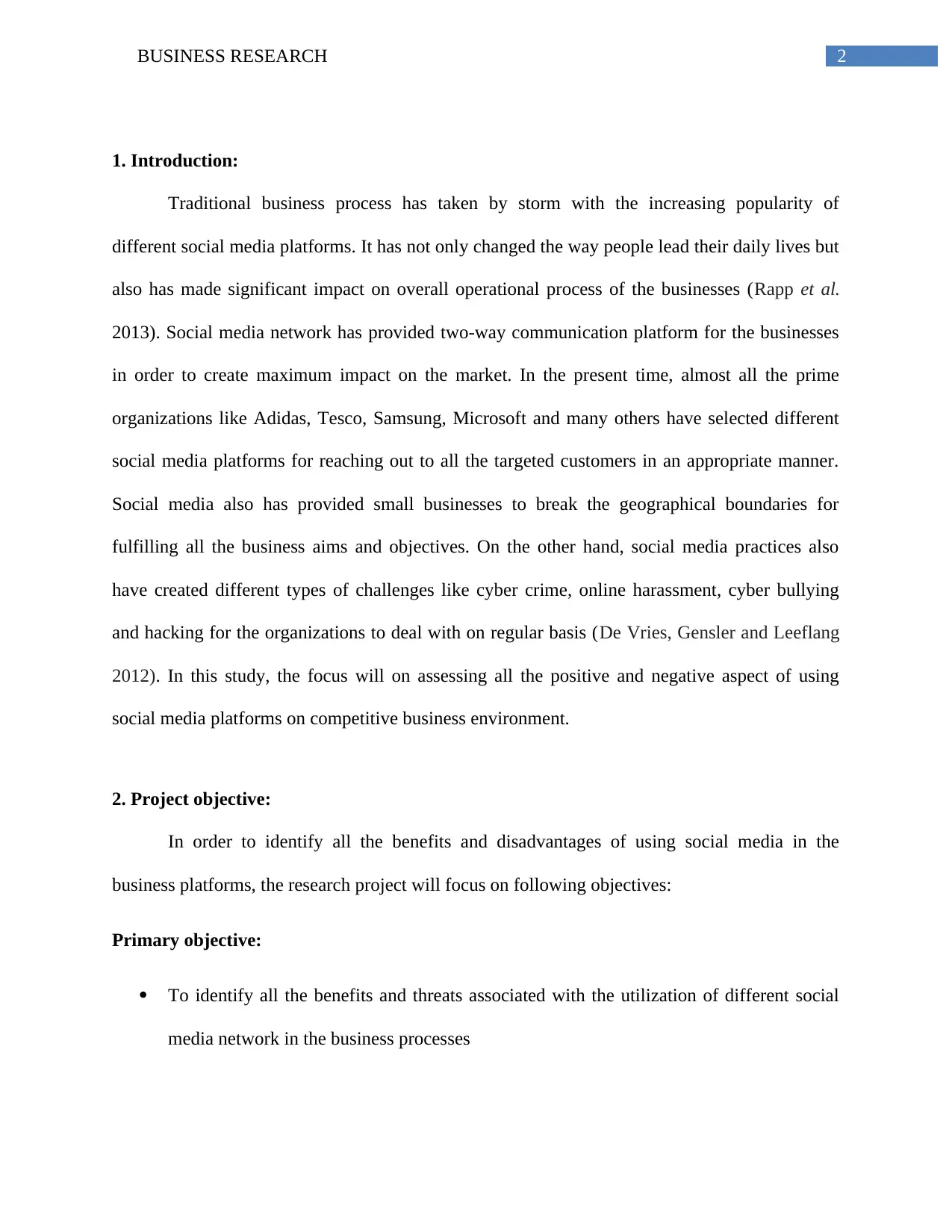
2BUSINESS RESEARCH
1. Introduction:
Traditional business process has taken by storm with the increasing popularity of
different social media platforms. It has not only changed the way people lead their daily lives but
also has made significant impact on overall operational process of the businesses (Rapp et al.
2013). Social media network has provided two-way communication platform for the businesses
in order to create maximum impact on the market. In the present time, almost all the prime
organizations like Adidas, Tesco, Samsung, Microsoft and many others have selected different
social media platforms for reaching out to all the targeted customers in an appropriate manner.
Social media also has provided small businesses to break the geographical boundaries for
fulfilling all the business aims and objectives. On the other hand, social media practices also
have created different types of challenges like cyber crime, online harassment, cyber bullying
and hacking for the organizations to deal with on regular basis (De Vries, Gensler and Leeflang
2012). In this study, the focus will on assessing all the positive and negative aspect of using
social media platforms on competitive business environment.
2. Project objective:
In order to identify all the benefits and disadvantages of using social media in the
business platforms, the research project will focus on following objectives:
Primary objective:
To identify all the benefits and threats associated with the utilization of different social
media network in the business processes
1. Introduction:
Traditional business process has taken by storm with the increasing popularity of
different social media platforms. It has not only changed the way people lead their daily lives but
also has made significant impact on overall operational process of the businesses (Rapp et al.
2013). Social media network has provided two-way communication platform for the businesses
in order to create maximum impact on the market. In the present time, almost all the prime
organizations like Adidas, Tesco, Samsung, Microsoft and many others have selected different
social media platforms for reaching out to all the targeted customers in an appropriate manner.
Social media also has provided small businesses to break the geographical boundaries for
fulfilling all the business aims and objectives. On the other hand, social media practices also
have created different types of challenges like cyber crime, online harassment, cyber bullying
and hacking for the organizations to deal with on regular basis (De Vries, Gensler and Leeflang
2012). In this study, the focus will on assessing all the positive and negative aspect of using
social media platforms on competitive business environment.
2. Project objective:
In order to identify all the benefits and disadvantages of using social media in the
business platforms, the research project will focus on following objectives:
Primary objective:
To identify all the benefits and threats associated with the utilization of different social
media network in the business processes
⊘ This is a preview!⊘
Do you want full access?
Subscribe today to unlock all pages.

Trusted by 1+ million students worldwide
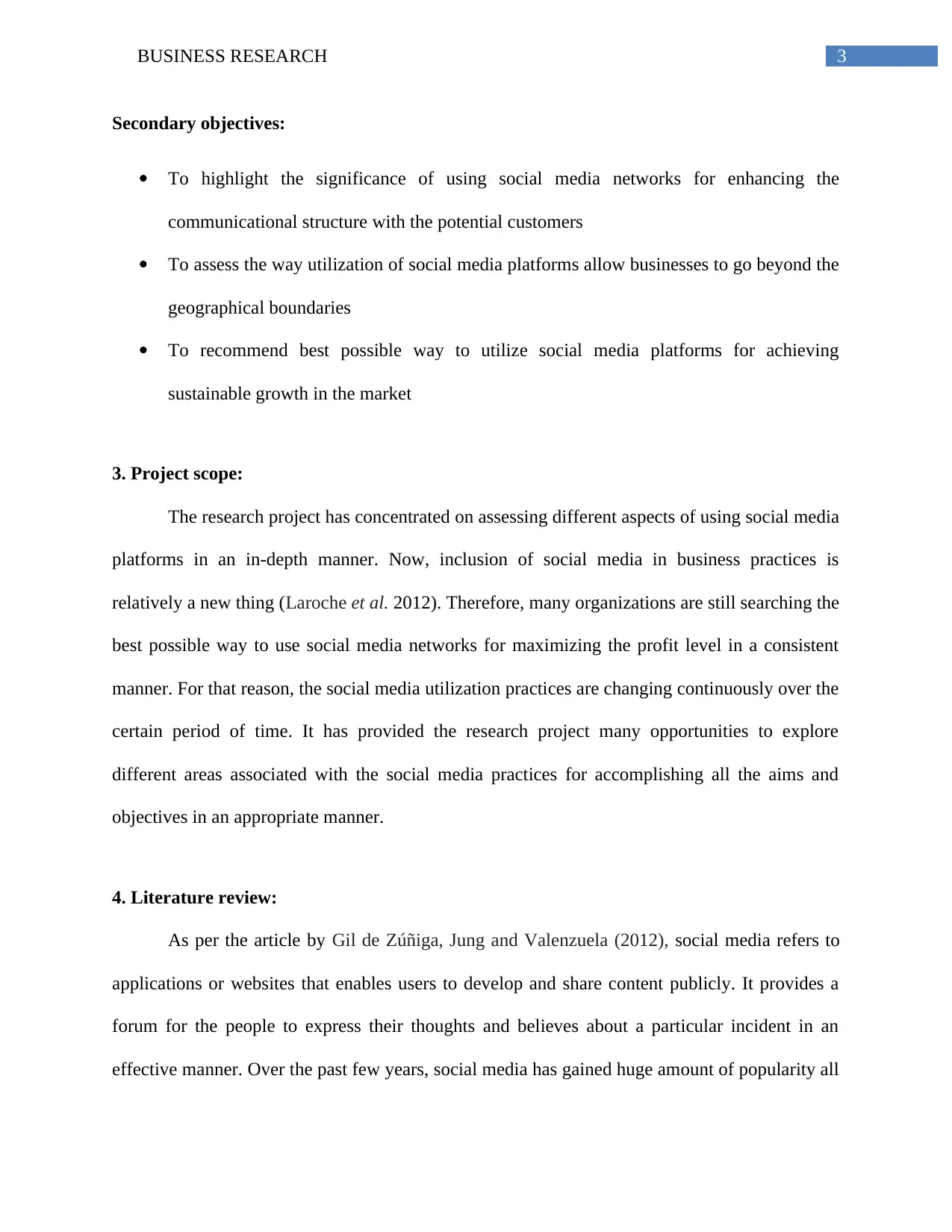
3BUSINESS RESEARCH
Secondary objectives:
To highlight the significance of using social media networks for enhancing the
communicational structure with the potential customers
To assess the way utilization of social media platforms allow businesses to go beyond the
geographical boundaries
To recommend best possible way to utilize social media platforms for achieving
sustainable growth in the market
3. Project scope:
The research project has concentrated on assessing different aspects of using social media
platforms in an in-depth manner. Now, inclusion of social media in business practices is
relatively a new thing (Laroche et al. 2012). Therefore, many organizations are still searching the
best possible way to use social media networks for maximizing the profit level in a consistent
manner. For that reason, the social media utilization practices are changing continuously over the
certain period of time. It has provided the research project many opportunities to explore
different areas associated with the social media practices for accomplishing all the aims and
objectives in an appropriate manner.
4. Literature review:
As per the article by Gil de Zúñiga, Jung and Valenzuela (2012), social media refers to
applications or websites that enables users to develop and share content publicly. It provides a
forum for the people to express their thoughts and believes about a particular incident in an
effective manner. Over the past few years, social media has gained huge amount of popularity all
Secondary objectives:
To highlight the significance of using social media networks for enhancing the
communicational structure with the potential customers
To assess the way utilization of social media platforms allow businesses to go beyond the
geographical boundaries
To recommend best possible way to utilize social media platforms for achieving
sustainable growth in the market
3. Project scope:
The research project has concentrated on assessing different aspects of using social media
platforms in an in-depth manner. Now, inclusion of social media in business practices is
relatively a new thing (Laroche et al. 2012). Therefore, many organizations are still searching the
best possible way to use social media networks for maximizing the profit level in a consistent
manner. For that reason, the social media utilization practices are changing continuously over the
certain period of time. It has provided the research project many opportunities to explore
different areas associated with the social media practices for accomplishing all the aims and
objectives in an appropriate manner.
4. Literature review:
As per the article by Gil de Zúñiga, Jung and Valenzuela (2012), social media refers to
applications or websites that enables users to develop and share content publicly. It provides a
forum for the people to express their thoughts and believes about a particular incident in an
effective manner. Over the past few years, social media has gained huge amount of popularity all
Paraphrase This Document
Need a fresh take? Get an instant paraphrase of this document with our AI Paraphraser
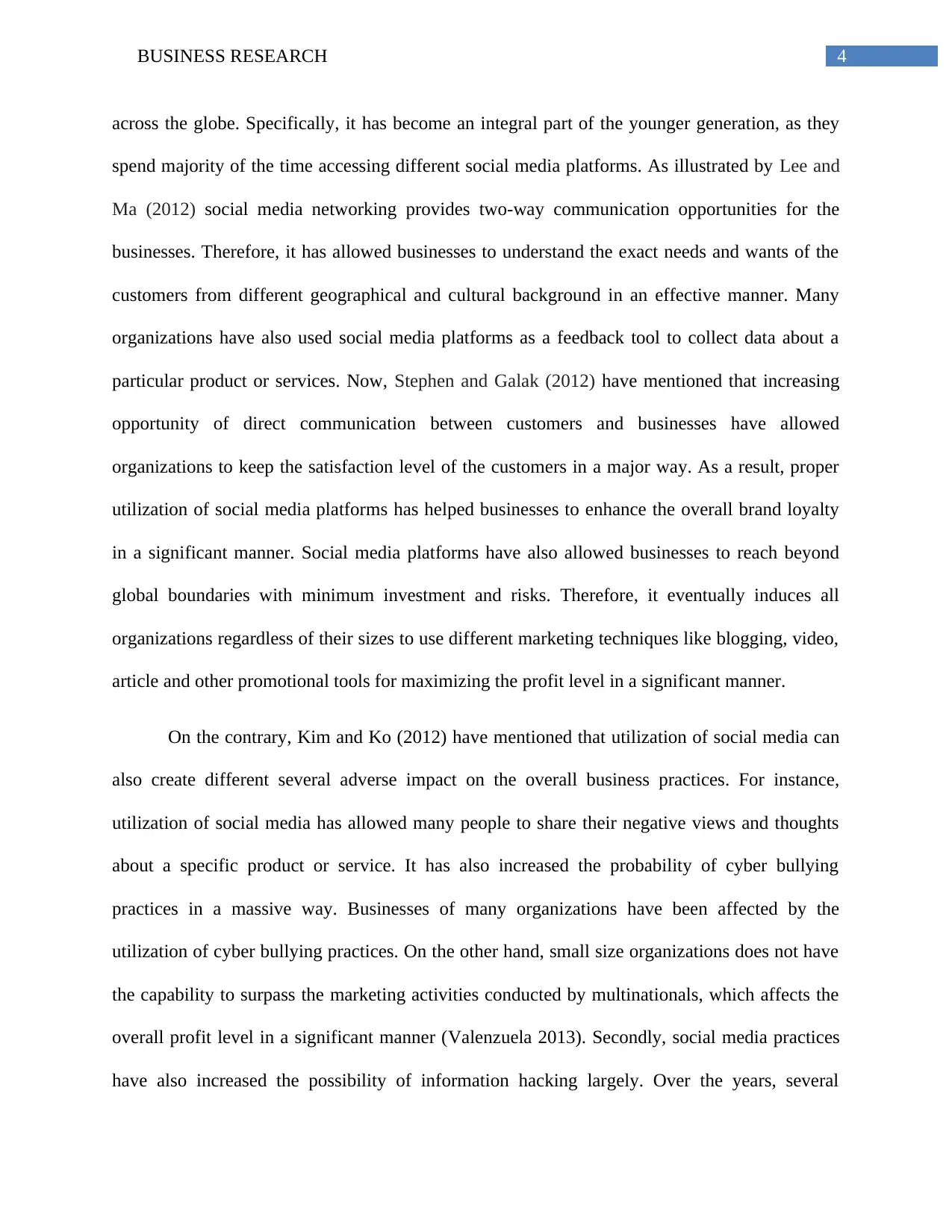
4BUSINESS RESEARCH
across the globe. Specifically, it has become an integral part of the younger generation, as they
spend majority of the time accessing different social media platforms. As illustrated by Lee and
Ma (2012) social media networking provides two-way communication opportunities for the
businesses. Therefore, it has allowed businesses to understand the exact needs and wants of the
customers from different geographical and cultural background in an effective manner. Many
organizations have also used social media platforms as a feedback tool to collect data about a
particular product or services. Now, Stephen and Galak (2012) have mentioned that increasing
opportunity of direct communication between customers and businesses have allowed
organizations to keep the satisfaction level of the customers in a major way. As a result, proper
utilization of social media platforms has helped businesses to enhance the overall brand loyalty
in a significant manner. Social media platforms have also allowed businesses to reach beyond
global boundaries with minimum investment and risks. Therefore, it eventually induces all
organizations regardless of their sizes to use different marketing techniques like blogging, video,
article and other promotional tools for maximizing the profit level in a significant manner.
On the contrary, Kim and Ko (2012) have mentioned that utilization of social media can
also create different several adverse impact on the overall business practices. For instance,
utilization of social media has allowed many people to share their negative views and thoughts
about a specific product or service. It has also increased the probability of cyber bullying
practices in a massive way. Businesses of many organizations have been affected by the
utilization of cyber bullying practices. On the other hand, small size organizations does not have
the capability to surpass the marketing activities conducted by multinationals, which affects the
overall profit level in a significant manner (Valenzuela 2013). Secondly, social media practices
have also increased the possibility of information hacking largely. Over the years, several
across the globe. Specifically, it has become an integral part of the younger generation, as they
spend majority of the time accessing different social media platforms. As illustrated by Lee and
Ma (2012) social media networking provides two-way communication opportunities for the
businesses. Therefore, it has allowed businesses to understand the exact needs and wants of the
customers from different geographical and cultural background in an effective manner. Many
organizations have also used social media platforms as a feedback tool to collect data about a
particular product or services. Now, Stephen and Galak (2012) have mentioned that increasing
opportunity of direct communication between customers and businesses have allowed
organizations to keep the satisfaction level of the customers in a major way. As a result, proper
utilization of social media platforms has helped businesses to enhance the overall brand loyalty
in a significant manner. Social media platforms have also allowed businesses to reach beyond
global boundaries with minimum investment and risks. Therefore, it eventually induces all
organizations regardless of their sizes to use different marketing techniques like blogging, video,
article and other promotional tools for maximizing the profit level in a significant manner.
On the contrary, Kim and Ko (2012) have mentioned that utilization of social media can
also create different several adverse impact on the overall business practices. For instance,
utilization of social media has allowed many people to share their negative views and thoughts
about a specific product or service. It has also increased the probability of cyber bullying
practices in a massive way. Businesses of many organizations have been affected by the
utilization of cyber bullying practices. On the other hand, small size organizations does not have
the capability to surpass the marketing activities conducted by multinationals, which affects the
overall profit level in a significant manner (Valenzuela 2013). Secondly, social media practices
have also increased the possibility of information hacking largely. Over the years, several
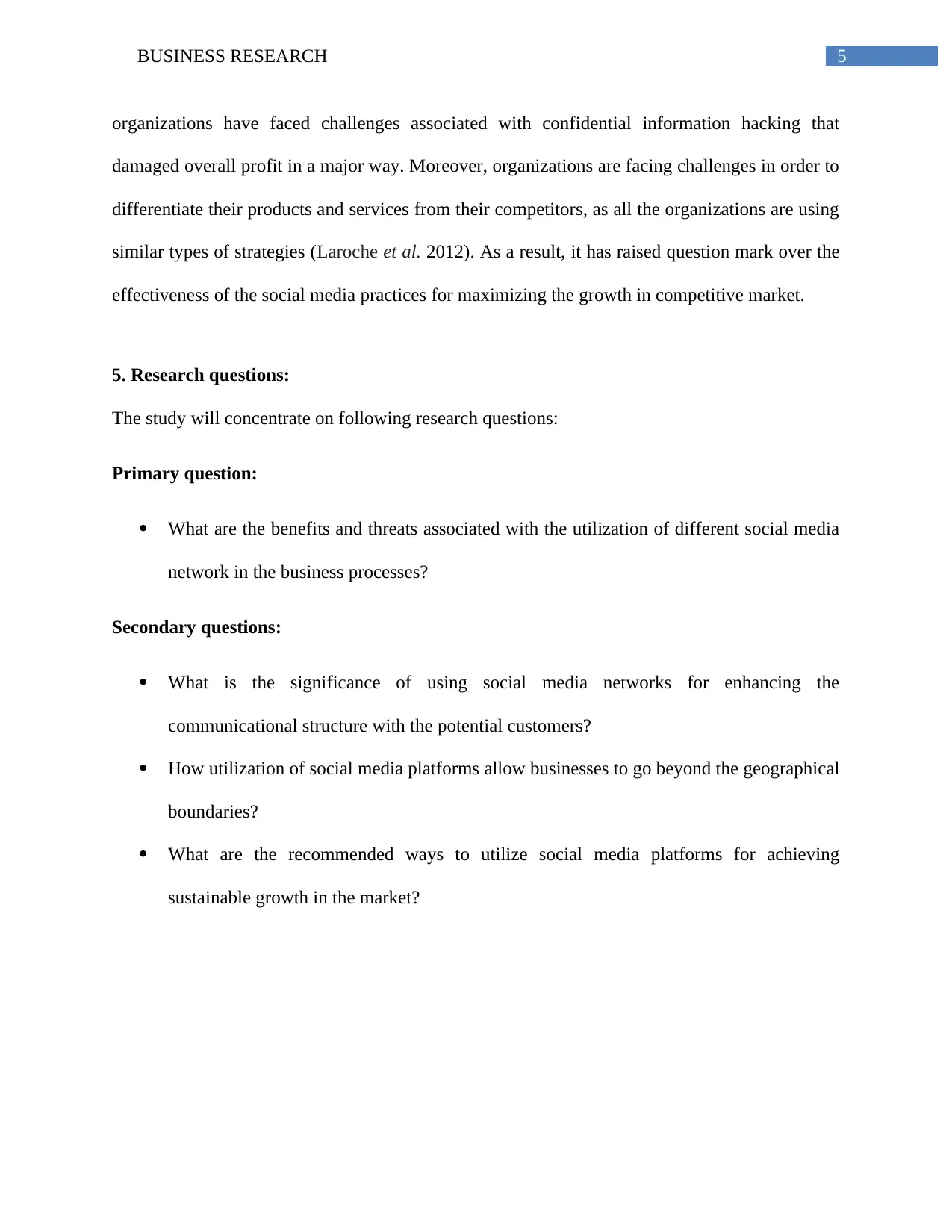
5BUSINESS RESEARCH
organizations have faced challenges associated with confidential information hacking that
damaged overall profit in a major way. Moreover, organizations are facing challenges in order to
differentiate their products and services from their competitors, as all the organizations are using
similar types of strategies (Laroche et al. 2012). As a result, it has raised question mark over the
effectiveness of the social media practices for maximizing the growth in competitive market.
5. Research questions:
The study will concentrate on following research questions:
Primary question:
What are the benefits and threats associated with the utilization of different social media
network in the business processes?
Secondary questions:
What is the significance of using social media networks for enhancing the
communicational structure with the potential customers?
How utilization of social media platforms allow businesses to go beyond the geographical
boundaries?
What are the recommended ways to utilize social media platforms for achieving
sustainable growth in the market?
organizations have faced challenges associated with confidential information hacking that
damaged overall profit in a major way. Moreover, organizations are facing challenges in order to
differentiate their products and services from their competitors, as all the organizations are using
similar types of strategies (Laroche et al. 2012). As a result, it has raised question mark over the
effectiveness of the social media practices for maximizing the growth in competitive market.
5. Research questions:
The study will concentrate on following research questions:
Primary question:
What are the benefits and threats associated with the utilization of different social media
network in the business processes?
Secondary questions:
What is the significance of using social media networks for enhancing the
communicational structure with the potential customers?
How utilization of social media platforms allow businesses to go beyond the geographical
boundaries?
What are the recommended ways to utilize social media platforms for achieving
sustainable growth in the market?
⊘ This is a preview!⊘
Do you want full access?
Subscribe today to unlock all pages.

Trusted by 1+ million students worldwide
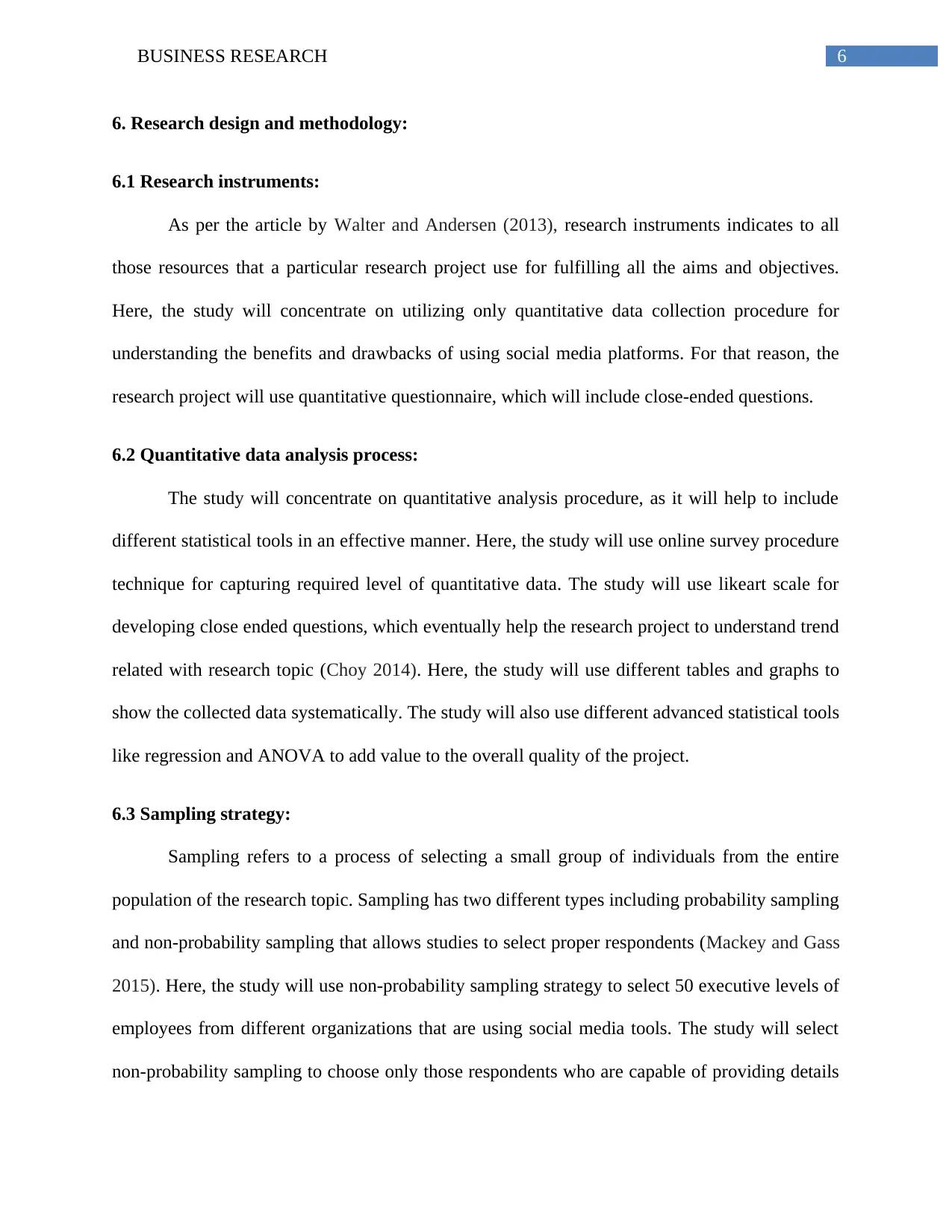
6BUSINESS RESEARCH
6. Research design and methodology:
6.1 Research instruments:
As per the article by Walter and Andersen (2013), research instruments indicates to all
those resources that a particular research project use for fulfilling all the aims and objectives.
Here, the study will concentrate on utilizing only quantitative data collection procedure for
understanding the benefits and drawbacks of using social media platforms. For that reason, the
research project will use quantitative questionnaire, which will include close-ended questions.
6.2 Quantitative data analysis process:
The study will concentrate on quantitative analysis procedure, as it will help to include
different statistical tools in an effective manner. Here, the study will use online survey procedure
technique for capturing required level of quantitative data. The study will use likeart scale for
developing close ended questions, which eventually help the research project to understand trend
related with research topic (Choy 2014). Here, the study will use different tables and graphs to
show the collected data systematically. The study will also use different advanced statistical tools
like regression and ANOVA to add value to the overall quality of the project.
6.3 Sampling strategy:
Sampling refers to a process of selecting a small group of individuals from the entire
population of the research topic. Sampling has two different types including probability sampling
and non-probability sampling that allows studies to select proper respondents (Mackey and Gass
2015). Here, the study will use non-probability sampling strategy to select 50 executive levels of
employees from different organizations that are using social media tools. The study will select
non-probability sampling to choose only those respondents who are capable of providing details
6. Research design and methodology:
6.1 Research instruments:
As per the article by Walter and Andersen (2013), research instruments indicates to all
those resources that a particular research project use for fulfilling all the aims and objectives.
Here, the study will concentrate on utilizing only quantitative data collection procedure for
understanding the benefits and drawbacks of using social media platforms. For that reason, the
research project will use quantitative questionnaire, which will include close-ended questions.
6.2 Quantitative data analysis process:
The study will concentrate on quantitative analysis procedure, as it will help to include
different statistical tools in an effective manner. Here, the study will use online survey procedure
technique for capturing required level of quantitative data. The study will use likeart scale for
developing close ended questions, which eventually help the research project to understand trend
related with research topic (Choy 2014). Here, the study will use different tables and graphs to
show the collected data systematically. The study will also use different advanced statistical tools
like regression and ANOVA to add value to the overall quality of the project.
6.3 Sampling strategy:
Sampling refers to a process of selecting a small group of individuals from the entire
population of the research topic. Sampling has two different types including probability sampling
and non-probability sampling that allows studies to select proper respondents (Mackey and Gass
2015). Here, the study will use non-probability sampling strategy to select 50 executive levels of
employees from different organizations that are using social media tools. The study will select
non-probability sampling to choose only those respondents who are capable of providing details
Paraphrase This Document
Need a fresh take? Get an instant paraphrase of this document with our AI Paraphraser
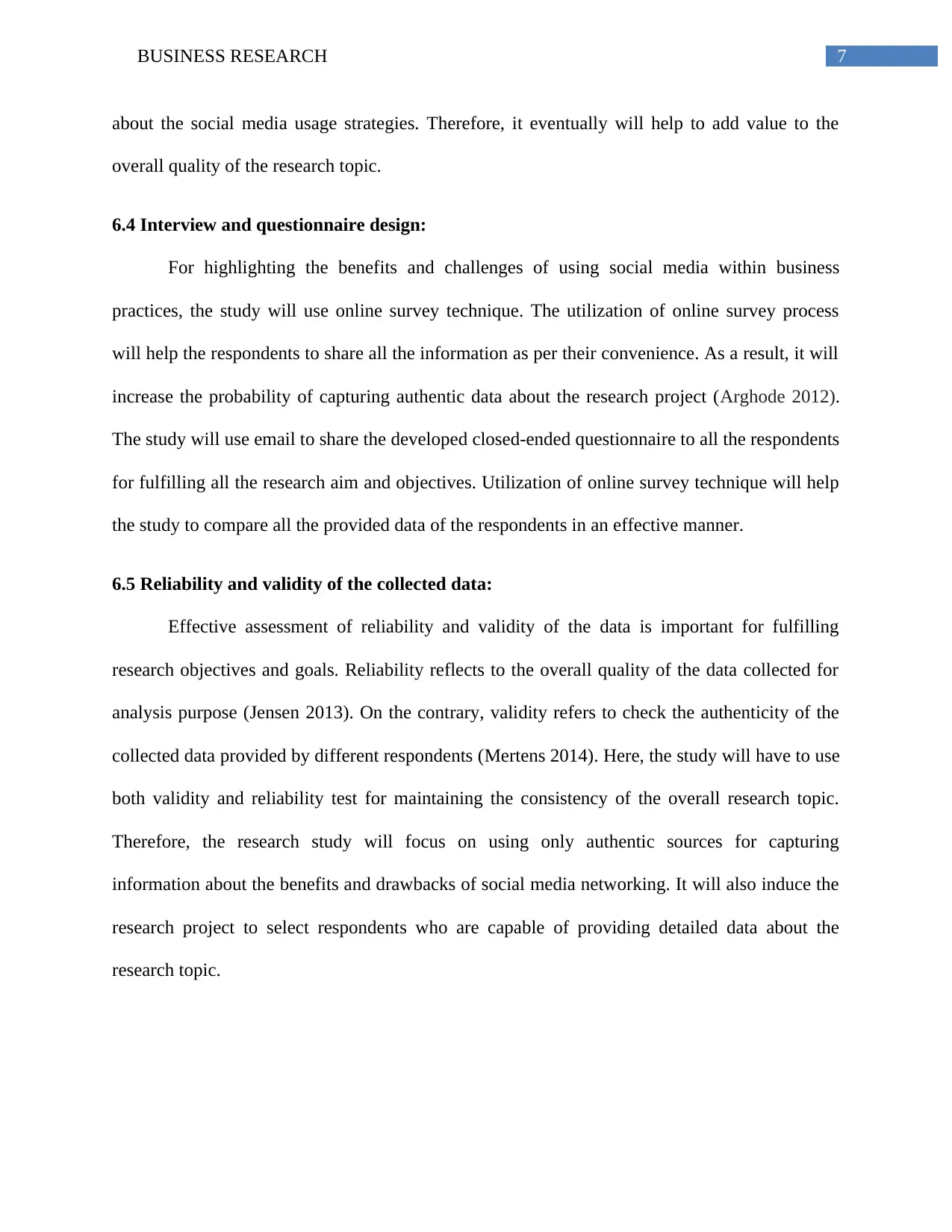
7BUSINESS RESEARCH
about the social media usage strategies. Therefore, it eventually will help to add value to the
overall quality of the research topic.
6.4 Interview and questionnaire design:
For highlighting the benefits and challenges of using social media within business
practices, the study will use online survey technique. The utilization of online survey process
will help the respondents to share all the information as per their convenience. As a result, it will
increase the probability of capturing authentic data about the research project (Arghode 2012).
The study will use email to share the developed closed-ended questionnaire to all the respondents
for fulfilling all the research aim and objectives. Utilization of online survey technique will help
the study to compare all the provided data of the respondents in an effective manner.
6.5 Reliability and validity of the collected data:
Effective assessment of reliability and validity of the data is important for fulfilling
research objectives and goals. Reliability reflects to the overall quality of the data collected for
analysis purpose (Jensen 2013). On the contrary, validity refers to check the authenticity of the
collected data provided by different respondents (Mertens 2014). Here, the study will have to use
both validity and reliability test for maintaining the consistency of the overall research topic.
Therefore, the research study will focus on using only authentic sources for capturing
information about the benefits and drawbacks of social media networking. It will also induce the
research project to select respondents who are capable of providing detailed data about the
research topic.
about the social media usage strategies. Therefore, it eventually will help to add value to the
overall quality of the research topic.
6.4 Interview and questionnaire design:
For highlighting the benefits and challenges of using social media within business
practices, the study will use online survey technique. The utilization of online survey process
will help the respondents to share all the information as per their convenience. As a result, it will
increase the probability of capturing authentic data about the research project (Arghode 2012).
The study will use email to share the developed closed-ended questionnaire to all the respondents
for fulfilling all the research aim and objectives. Utilization of online survey technique will help
the study to compare all the provided data of the respondents in an effective manner.
6.5 Reliability and validity of the collected data:
Effective assessment of reliability and validity of the data is important for fulfilling
research objectives and goals. Reliability reflects to the overall quality of the data collected for
analysis purpose (Jensen 2013). On the contrary, validity refers to check the authenticity of the
collected data provided by different respondents (Mertens 2014). Here, the study will have to use
both validity and reliability test for maintaining the consistency of the overall research topic.
Therefore, the research study will focus on using only authentic sources for capturing
information about the benefits and drawbacks of social media networking. It will also induce the
research project to select respondents who are capable of providing detailed data about the
research topic.
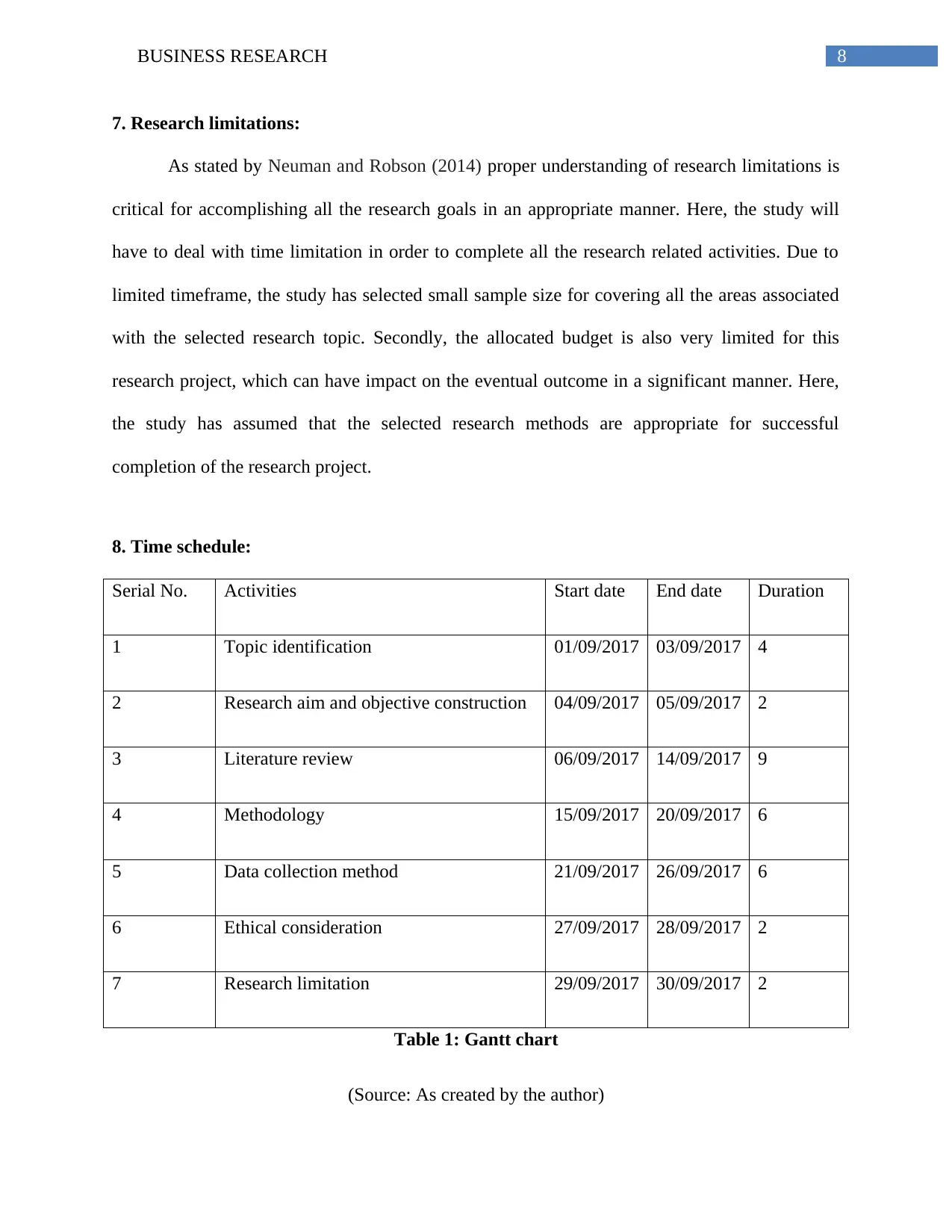
8BUSINESS RESEARCH
7. Research limitations:
As stated by Neuman and Robson (2014) proper understanding of research limitations is
critical for accomplishing all the research goals in an appropriate manner. Here, the study will
have to deal with time limitation in order to complete all the research related activities. Due to
limited timeframe, the study has selected small sample size for covering all the areas associated
with the selected research topic. Secondly, the allocated budget is also very limited for this
research project, which can have impact on the eventual outcome in a significant manner. Here,
the study has assumed that the selected research methods are appropriate for successful
completion of the research project.
8. Time schedule:
Serial No. Activities Start date End date Duration
1 Topic identification 01/09/2017 03/09/2017 4
2 Research aim and objective construction 04/09/2017 05/09/2017 2
3 Literature review 06/09/2017 14/09/2017 9
4 Methodology 15/09/2017 20/09/2017 6
5 Data collection method 21/09/2017 26/09/2017 6
6 Ethical consideration 27/09/2017 28/09/2017 2
7 Research limitation 29/09/2017 30/09/2017 2
Table 1: Gantt chart
(Source: As created by the author)
7. Research limitations:
As stated by Neuman and Robson (2014) proper understanding of research limitations is
critical for accomplishing all the research goals in an appropriate manner. Here, the study will
have to deal with time limitation in order to complete all the research related activities. Due to
limited timeframe, the study has selected small sample size for covering all the areas associated
with the selected research topic. Secondly, the allocated budget is also very limited for this
research project, which can have impact on the eventual outcome in a significant manner. Here,
the study has assumed that the selected research methods are appropriate for successful
completion of the research project.
8. Time schedule:
Serial No. Activities Start date End date Duration
1 Topic identification 01/09/2017 03/09/2017 4
2 Research aim and objective construction 04/09/2017 05/09/2017 2
3 Literature review 06/09/2017 14/09/2017 9
4 Methodology 15/09/2017 20/09/2017 6
5 Data collection method 21/09/2017 26/09/2017 6
6 Ethical consideration 27/09/2017 28/09/2017 2
7 Research limitation 29/09/2017 30/09/2017 2
Table 1: Gantt chart
(Source: As created by the author)
⊘ This is a preview!⊘
Do you want full access?
Subscribe today to unlock all pages.

Trusted by 1+ million students worldwide
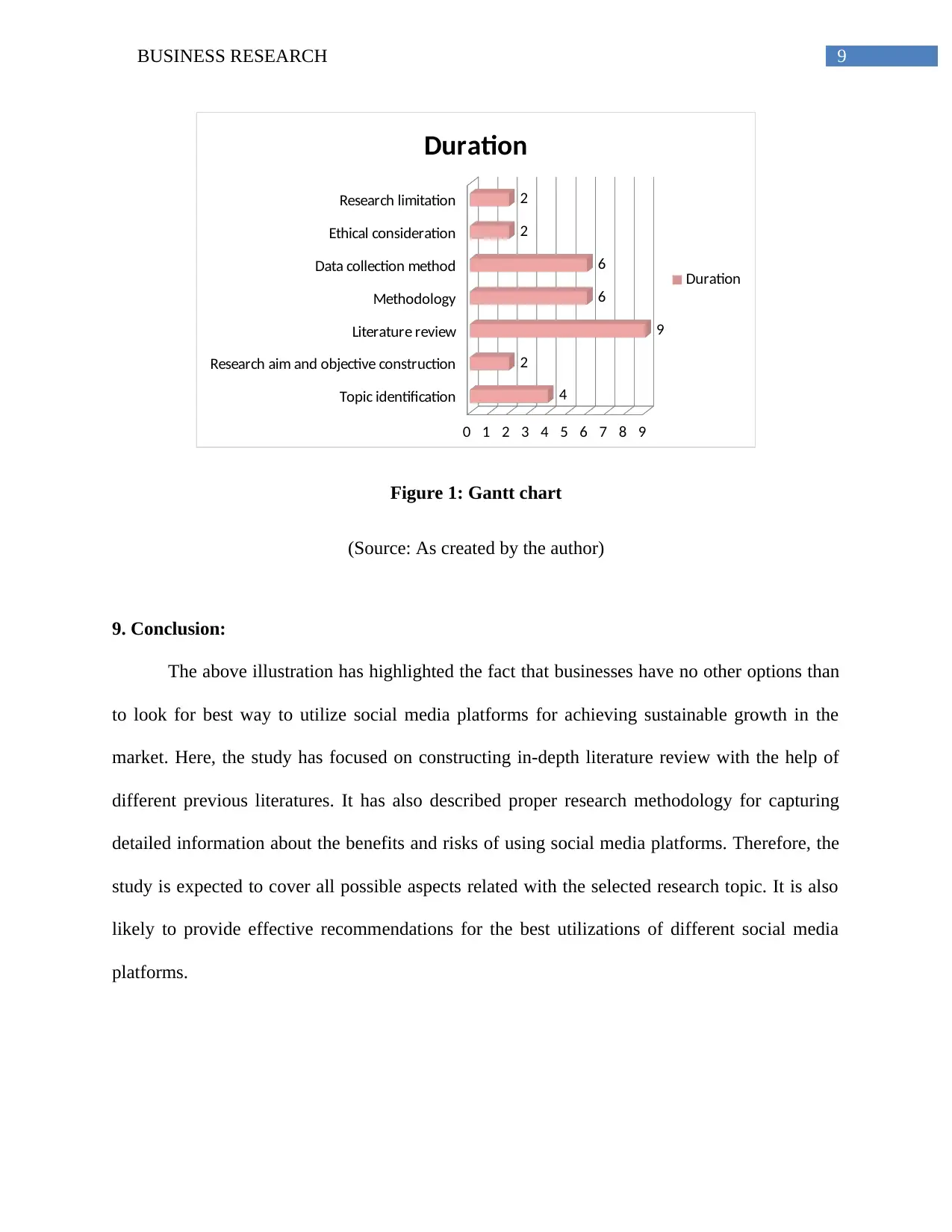
9BUSINESS RESEARCH
Topic identification
Research aim and objective construction
Literature review
Methodology
Data collection method
Ethical consideration
Research limitation
0 1 2 3 4 5 6 7 8 9
4
2
9
6
6
2
2
Duration
Duration
Figure 1: Gantt chart
(Source: As created by the author)
9. Conclusion:
The above illustration has highlighted the fact that businesses have no other options than
to look for best way to utilize social media platforms for achieving sustainable growth in the
market. Here, the study has focused on constructing in-depth literature review with the help of
different previous literatures. It has also described proper research methodology for capturing
detailed information about the benefits and risks of using social media platforms. Therefore, the
study is expected to cover all possible aspects related with the selected research topic. It is also
likely to provide effective recommendations for the best utilizations of different social media
platforms.
Topic identification
Research aim and objective construction
Literature review
Methodology
Data collection method
Ethical consideration
Research limitation
0 1 2 3 4 5 6 7 8 9
4
2
9
6
6
2
2
Duration
Duration
Figure 1: Gantt chart
(Source: As created by the author)
9. Conclusion:
The above illustration has highlighted the fact that businesses have no other options than
to look for best way to utilize social media platforms for achieving sustainable growth in the
market. Here, the study has focused on constructing in-depth literature review with the help of
different previous literatures. It has also described proper research methodology for capturing
detailed information about the benefits and risks of using social media platforms. Therefore, the
study is expected to cover all possible aspects related with the selected research topic. It is also
likely to provide effective recommendations for the best utilizations of different social media
platforms.
Paraphrase This Document
Need a fresh take? Get an instant paraphrase of this document with our AI Paraphraser
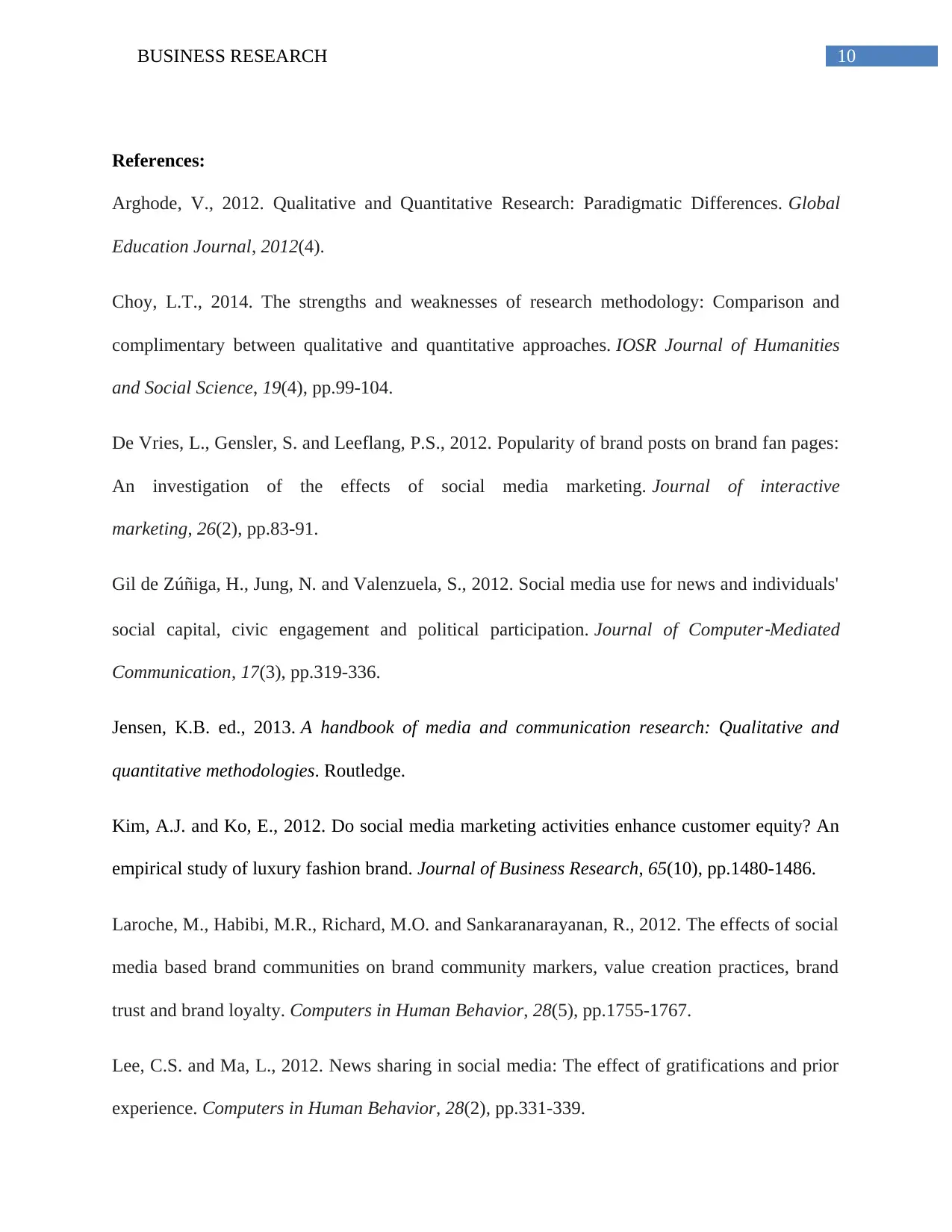
10BUSINESS RESEARCH
References:
Arghode, V., 2012. Qualitative and Quantitative Research: Paradigmatic Differences. Global
Education Journal, 2012(4).
Choy, L.T., 2014. The strengths and weaknesses of research methodology: Comparison and
complimentary between qualitative and quantitative approaches. IOSR Journal of Humanities
and Social Science, 19(4), pp.99-104.
De Vries, L., Gensler, S. and Leeflang, P.S., 2012. Popularity of brand posts on brand fan pages:
An investigation of the effects of social media marketing. Journal of interactive
marketing, 26(2), pp.83-91.
Gil de Zúñiga, H., Jung, N. and Valenzuela, S., 2012. Social media use for news and individuals'
social capital, civic engagement and political participation. Journal of Computer
‐Mediated
Communication, 17(3), pp.319-336.
Jensen, K.B. ed., 2013. A handbook of media and communication research: Qualitative and
quantitative methodologies. Routledge.
Kim, A.J. and Ko, E., 2012. Do social media marketing activities enhance customer equity? An
empirical study of luxury fashion brand. Journal of Business Research, 65(10), pp.1480-1486.
Laroche, M., Habibi, M.R., Richard, M.O. and Sankaranarayanan, R., 2012. The effects of social
media based brand communities on brand community markers, value creation practices, brand
trust and brand loyalty. Computers in Human Behavior, 28(5), pp.1755-1767.
Lee, C.S. and Ma, L., 2012. News sharing in social media: The effect of gratifications and prior
experience. Computers in Human Behavior, 28(2), pp.331-339.
References:
Arghode, V., 2012. Qualitative and Quantitative Research: Paradigmatic Differences. Global
Education Journal, 2012(4).
Choy, L.T., 2014. The strengths and weaknesses of research methodology: Comparison and
complimentary between qualitative and quantitative approaches. IOSR Journal of Humanities
and Social Science, 19(4), pp.99-104.
De Vries, L., Gensler, S. and Leeflang, P.S., 2012. Popularity of brand posts on brand fan pages:
An investigation of the effects of social media marketing. Journal of interactive
marketing, 26(2), pp.83-91.
Gil de Zúñiga, H., Jung, N. and Valenzuela, S., 2012. Social media use for news and individuals'
social capital, civic engagement and political participation. Journal of Computer
‐Mediated
Communication, 17(3), pp.319-336.
Jensen, K.B. ed., 2013. A handbook of media and communication research: Qualitative and
quantitative methodologies. Routledge.
Kim, A.J. and Ko, E., 2012. Do social media marketing activities enhance customer equity? An
empirical study of luxury fashion brand. Journal of Business Research, 65(10), pp.1480-1486.
Laroche, M., Habibi, M.R., Richard, M.O. and Sankaranarayanan, R., 2012. The effects of social
media based brand communities on brand community markers, value creation practices, brand
trust and brand loyalty. Computers in Human Behavior, 28(5), pp.1755-1767.
Lee, C.S. and Ma, L., 2012. News sharing in social media: The effect of gratifications and prior
experience. Computers in Human Behavior, 28(2), pp.331-339.
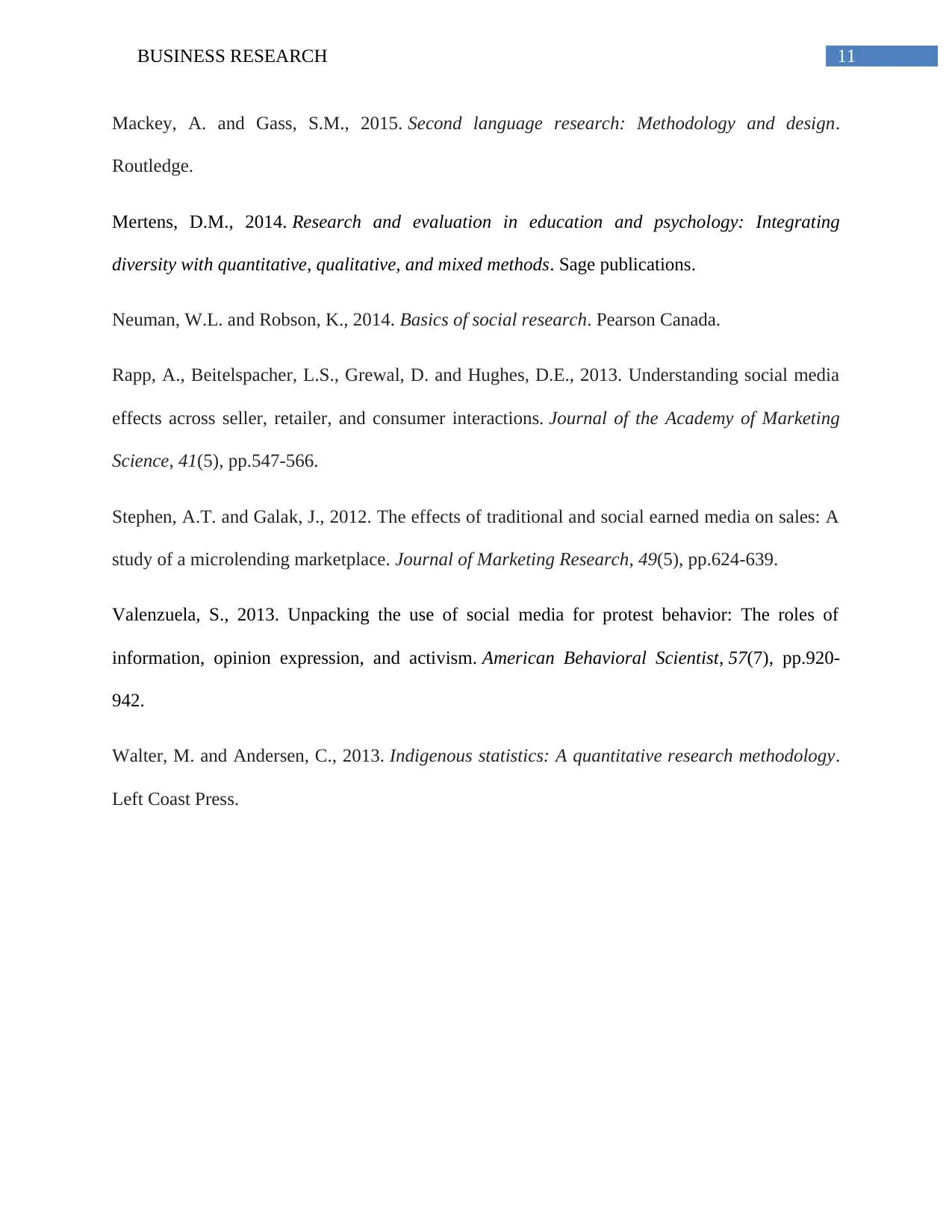
11BUSINESS RESEARCH
Mackey, A. and Gass, S.M., 2015. Second language research: Methodology and design.
Routledge.
Mertens, D.M., 2014. Research and evaluation in education and psychology: Integrating
diversity with quantitative, qualitative, and mixed methods. Sage publications.
Neuman, W.L. and Robson, K., 2014. Basics of social research. Pearson Canada.
Rapp, A., Beitelspacher, L.S., Grewal, D. and Hughes, D.E., 2013. Understanding social media
effects across seller, retailer, and consumer interactions. Journal of the Academy of Marketing
Science, 41(5), pp.547-566.
Stephen, A.T. and Galak, J., 2012. The effects of traditional and social earned media on sales: A
study of a microlending marketplace. Journal of Marketing Research, 49(5), pp.624-639.
Valenzuela, S., 2013. Unpacking the use of social media for protest behavior: The roles of
information, opinion expression, and activism. American Behavioral Scientist, 57(7), pp.920-
942.
Walter, M. and Andersen, C., 2013. Indigenous statistics: A quantitative research methodology.
Left Coast Press.
Mackey, A. and Gass, S.M., 2015. Second language research: Methodology and design.
Routledge.
Mertens, D.M., 2014. Research and evaluation in education and psychology: Integrating
diversity with quantitative, qualitative, and mixed methods. Sage publications.
Neuman, W.L. and Robson, K., 2014. Basics of social research. Pearson Canada.
Rapp, A., Beitelspacher, L.S., Grewal, D. and Hughes, D.E., 2013. Understanding social media
effects across seller, retailer, and consumer interactions. Journal of the Academy of Marketing
Science, 41(5), pp.547-566.
Stephen, A.T. and Galak, J., 2012. The effects of traditional and social earned media on sales: A
study of a microlending marketplace. Journal of Marketing Research, 49(5), pp.624-639.
Valenzuela, S., 2013. Unpacking the use of social media for protest behavior: The roles of
information, opinion expression, and activism. American Behavioral Scientist, 57(7), pp.920-
942.
Walter, M. and Andersen, C., 2013. Indigenous statistics: A quantitative research methodology.
Left Coast Press.
⊘ This is a preview!⊘
Do you want full access?
Subscribe today to unlock all pages.

Trusted by 1+ million students worldwide
1 out of 12
Related Documents
Your All-in-One AI-Powered Toolkit for Academic Success.
+13062052269
info@desklib.com
Available 24*7 on WhatsApp / Email
![[object Object]](/_next/static/media/star-bottom.7253800d.svg)
Unlock your academic potential
Copyright © 2020–2025 A2Z Services. All Rights Reserved. Developed and managed by ZUCOL.




